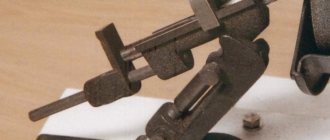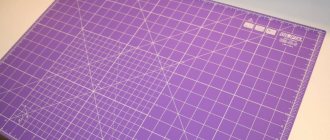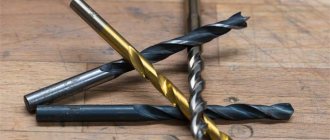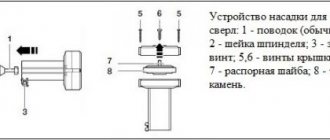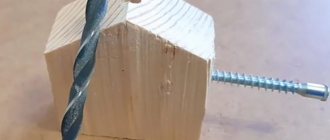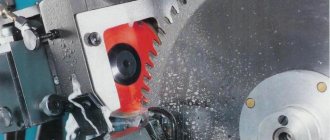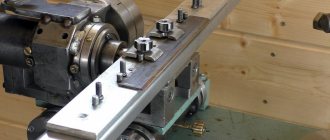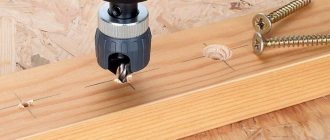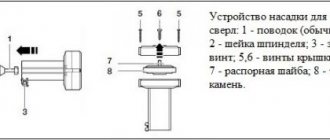A problem arose: to repair the equipment, I needed to accurately drill several holes with a diameter of 2 mm in a steel plate, and the drills turned out to be so blunt that they burned and did not work.
I tried to sharpen them on a homemade sandpaper made from a three-phase asynchronous motor with a simple capacitor start. The machine in the photo: a tool rest with markings for sharpening drills.
However, my skills and coarse-grained corundum stone allow me to edit drills from 4 mm relatively well, but problems arise with smaller diameters. You need professional equipment.
This need shaped the task: to make by hand a device for sharpening small drills, as simple and reliable as a metal bolt. I took as a basis an idea from the Internet (used for a long time) called Wishbone (in our opinion - Wishbone), which I talk about below in this article.
I had to work in the evenings in the kitchen of a city apartment, not a private house, after all stages of dinner had been completed. Naturally, I sawed, drilled and leveled almost on my knees with the most accessible hand tools.
Therefore, Vishbon was completed only on the second day, although in a workshop, using a grinder and a drilling machine, it can be done in a couple of hours.
In general, advanced users quickly print this device on a 3D printer and get high-quality samples of hand tools.
Wishbone - what a drill sharpening device can do and what functions it cannot do
This product allows you to fix dull and broken twist drills quite quickly and shape their cutting edges, just like in a factory for home use.
The main feature of the device: it does not require high sharpening skills; anyone can use it. The design is not complicated.
It’s worth immediately taking into account that such a homemade product only performs two-plane sharpening. Its capabilities are limited to two functions:
- by forming an angle at the apex, and you can deviate from the standard value for steel of 120 degrees and grind other values. A table of the dependence of angles and parameters of different types of processed material are published in reference books;
- creating a rear cutting angle.
Apex angle
Relief cutting angle
You can talk about them for a long time, but it’s unlikely that it will be better than Viktor Leontyev (a real master) on his YouTube channel. For those who don't know this, look there. I think I should warn you - this is important!
In principle, the correct creation of these two angles is sufficient for working with small drills at home, and often in production. Sharpening the jumper with this device will not work. You need to use a special machine.
When should you sharpen a drill?
The need for sharpening can be determined by the following signs:
- significant heating of the cutting tool;
- excessively small chip size;
- Uncharacteristically loud noise during operation.
If the tool begins to make a lot of noise, you should stop working. The noise appears due to a significant increase in friction force. To avoid damaging the equipment, you need to stop drilling. If this is not done, the drill will overheat, after which it will no longer be possible to restore its cutting characteristics.
Personal experience of making a Wishbon instrument at home with your own hands
You can choose any body material, of different compositions:
- aluminum sheet or soft alloys;
- plastic;
- laminate or fiberboard;
- polyethylene or fiberglass;
- even a wooden plank.
I settled on a plate made of getinax: it is easy to process and has high strength.
To make the case, I drew a sketch on a squared notebook sheet. No drawings needed. Scale 1:1. I placed a small drill on it as a size guide.
For clarity, I outlined the dimensions with a red pencil and showed the corners.
After that, I drew the dimensions on the getinax. I drilled holes in the body of the future device.
Since I didn’t have a normal drill, I had to make a homemade one based on the cannon drill principle. I used a piece of a spoke from a Soviet bicycle. Diameter 2 mm.
I filed off part of the side edge and sharpened the end into a central corner. On the one hand, it is a parody of a cannon weapon, but it is a completely working design for soft materials.
It is permissible to make them even from nails and wire of different diameters. This way you can make different types and diameters of such tools. No special precision is required. My finished drills are shown in the photo.
From the getinax I used a hacksaw to cut out a body blank and an additional part for attaching the wheel - a regular washer for an M3 nut. I used a 4 square piece of copper wire as an axis. In order for the wheel to rotate well, a spacer had to be installed.
The method of connecting parts is conventional riveting. Vishbon showed the rest of the details in the photo.
The clamping block (a pentagonal figure in the photo) was made with holes with a diameter of 4 mm.
In the central part of the body, I had to use homemade drills to increase the diameter of the hole and cut the thread. I made the tap with my own hands from an M4 hairpin: I sharpened one end slightly into a cone and cut part of the thread along the length from opposite sides with a hacksaw.
From the opposite end of the thread, I clamped two nuts against each other, which allowed me to work with it with a wrench.
Homemade tap
I must warn you: it’s easier to work with a factory tap. But, in a critical situation and for soft materials, this design is justified.
In the middle of the 120 degree angle I scratched a bisector, which serves as the basis for laying the thinnest drill bits.
I reduced the height of the body so that even the smallest drills protrude from it: this makes it easier to install them.
In the upper part of this, Vishbon made a mark at the exit of the angle bisector to facilitate the assembly process: centering the axes of large drills when fixing them in the fixture.
The mark indicates the center of the drill.
Sharpening machines
The optimal device for sharpening drills with your own hands is a regular sharpening machine. But it is best to experiment with old equipment, since without experience the instrument can simply be ruined. If you have no experience working with emery, it is better to purchase a specialized machine.
Easy-to-use multifunctional sharpening devices are available on the market. You can purchase a simple manual machine or electrical appliance.
Modern models work almost automatically. The design provides not only a fixation mechanism, but also a supply mechanism for the sharpening tool.
This type of equipment is especially suitable for working with twist drills. However, the cost of such devices is quite high, so it is not practical to buy them for your home.
9 main rules for working with Wishbone, without which it is impossible to achieve a good result
I show them in the form of step-by-step instructions with a strict sequence of actions. However, keep in mind: there are two ways to work with Wishbon:
- straightening dull factory edges;
- bringing broken drills back into working condition.
How to straighten dull edges
1. Loosen the clamping screws and insert a drill under the fixing plate, tighten the fastening without fanaticism: you will need to make adjustments.
2. Using a magnifying glass, set the drill so that the cutting edges are parallel to the plane of the body or wheels. It is very convenient to turn it with pliers.
3. Adjust the sharpening angle at the tip. To do this, we install some kind of even guide, for example, a ruler, on the top of the drill and the wheel. The planes of the fixture and the reference line must be parallel.
But if you need to make the sharpening angle not 120 degrees, but less, then we simply move the drill a little higher, as in the photo.
To accurately set a certain degree value, the required angle is drawn on a sheet of paper using a protractor and its bisector is drawn. The device is oriented according to this template.
4. The fastening screws are tightened until they stop. The drill is fixed. After this, you need to repeat the measurements in steps 2 and 3. Be careful and careful as a necessary condition for accurate sharpening.
5. Place the Wishbone vertically on the grinding surface of an abrasive stone or sandpaper, laid on the most even surface, for example, glass or plastic.
Then we tilt it at a slight angle from the vertical to cut off the occipital region. At first, a simple template will help.
After sharpening several drills, it will lose relevance due to the skills developed.
6. All that remains is the sharpening itself: the Wishbone is lightly pressed against the abrasive surface of the sharpening device in the set position (large loads are harmful), and smoothly moved away from you, always placing the wheel in front.
Without reaching the end of the abrasive surface and without further touching it, the device is lifted and carried through the air to the beginning of the abrasive. The process is repeated several times.
During each sharpening, it is very important to always point the Wishbone in only one direction: away from you.
7. The Vishbon is rotated 180 degrees around the axis of the drill and completely repeats steps No. 5 and 6 for the second edge.
8. Using a magnifying glass (the eye gauge may fail), a visual assessment of the condition of the cutting edges, apex angles and rear cutting is made. If necessary, repeat steps No. 5 ÷ 8.
9. Sharpening ends with one pass for each side, which ensures the removal of the remaining burrs on each of the cutting edges. The edges will be perfect. I advise you to check it.
I should note: when I first made Wishbone and immediately began sharpening the drill for metal, acting on a whim, I neglected most of these rules. As a result of the test, it was possible to drill only an aluminum plate, but failed to drill a steel one. There was no hole.
I showed this entire process of sharpening and drilling in the video below. You should do everything right at once, without unnecessary haste.
How to sharpen a broken drill bit on Wishbone
The process described above for broken drills will take a very long time. Therefore, the damaged end must be ground off using an emery wheel.
You can also use a drill:
- insert the broken drill into it;
- turn on reverse;
- set an angle of 60 degrees to the sharpening stone. This tilt is important;
- start the engine;
- Carefully grind the broken end onto the cone. Follow safety requirements.
Now all that remains is to repeat all the steps to correct the edges and additionally restore their shape.
Good abrasives quickly grind down thin drill bits. Therefore, after 20 passes on the surface being treated, conduct a visual assessment of the cutting edges and angles and re-adjust them.
Ready-made sharpening attachments
It is very difficult to sharpen a drill on sandpaper without experience. Therefore, special attachments are produced for power tools. They are usually mounted on a drill.
The nozzle has a round shape and small dimensions. Can be designed for different angles and drill diameters. After installing the device on the drill, you need to insert a drill from the end. Next, you only need to turn on the device for a few seconds.
Sharpening of two-plane equipment is carried out in 2 stages. After the first pass, the drill should be removed, rotated 180°, and inserted back. This way both planes are sharpened.
It is impossible to make such a device with your own hands due to the difficulty of adjusting the dimensions. But, the cost of such devices is very low, in contrast to specialized machines.
Wishbone alternative design: what are the differences between the tool
An alternative is to mount the guide wheels across rather than along the main plane of the housing. I hope that making such a device is not difficult. But 3D printing will require drawings.
In this case, drills are sharpened perpendicular to the plane of the cutting edges. For some, this feature of the tool is fundamentally important...
I do not think so. It is necessary to take into account that a spiral drill for metal, using a stationary machine, can be sharpened in different ways:
- the already mentioned Victor Leontyev performs this action, placing the cutting edge across the rotation of the emery;
- sharpener Nikolai Kulikov places it parallel. Watch his channel “Kulikov Experience” on YouTube.
Both techniques of these experts work correctly and have a number of advantages and disadvantages. Welders sharpen drills with a grinder. They always have this tool at hand: it allows them to cut off any bolt, angle, channel, or fragments of metal elements.
Homemade people make a sharpening machine, which is adapted for straightening drill elements on the side of an emery wheel... Such devices, I must note, are not suitable for everyone.
There is no universal advice. Which design should be chosen and used for sharpening metal drills with your own hands - decide for yourself.
Drill selection criteria
There are many types of cutting equipment available for sale. When choosing, you should pay attention to the color of the metal:
- Black. A product with an anti-corrosion oxide film, which additionally prevents overheating. Wear-resistant, suitable for high loads.
- Grey. Low quality models for light loads.
- Golden. This color is due to the presence of titanium in the alloy, which increases strength.
- Dark golden. Also an alloy with titanium, but without internal stress in the rod. The highest quality drills for heavy loads.
According to the type of design, the following types of drills are distinguished:
- Traditional spiral. Suitable for most household tasks.
- Left-handed. For drilling out broken fasteners.
- Highly accurate. For delicate work where deviation from the design is unacceptable.
Mini electric drill sharpener from LEIMING
Price: from 2238.43 rub. (check price and discount)
Seller's reliability: excellent!
Delivery within Russia: free!
It took a very long time to travel, but the packaging was very good. Sharpens fine.
Makaroon
I am satisfied with the product, made with high quality. Recommended for purchase from this seller.
Bine
Arrived quickly (Moscow). The box was crushed and fell apart when the tape was cut. The sharpener is strong and not damaged. For those who don’t have a full hand and only have to drill from time to time, this is what they need.
FoPPi
View on AliExpress:
Briefly about the main thing
You can sharpen a dull drill using different devices: a sharpening machine, a drill on which a whetstone is installed, or a drill attachment.
Small drills are sharpened by hand with a file or needle file.
The main sharpening parameter is the angle that forms the edges. The sharpening angle is selected taking into account the metal that is to be drilled. This parameter is tabular.
To increase the wear resistance of the drill, the sharpening configuration is changed, using five options for edge formation as a basis.
